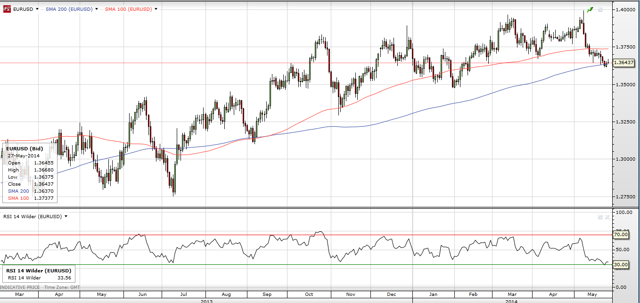Summary
- Euro failure seen at critical psychological level.
- Relative growth performance suggest a period of prolonged weakness.
- ECB could announce new stimulus measures as early as next week.
When we look at the currency markets, one of the biggest stories of the year has been the massive reversal in the Euro versus the Dollar (the EUR/USD forex pair). At its heights, the EUR/USD came within a few ticks of the closely watched 1.40 mark, only to stall and begin falling shortly after. Moves like this are not altogether surprising, as the forex markets are often directed by buy or sell orders that are placed within close proximity to big round numbers. So a much bigger reaction could have been expected if market valuations reached 1.50 but the fact that market valuations never reached this area is a telling feature and ultimately suggests that the highs for the full year have already been reached.
There are many reasons why this is occurring. I have outlined some of the weaknesses seen in the Eurozone’s recent economic reports. Most of the arguments for the bearish case come from the fact that unemployment across the region remains elevated at more than 11%, which is nearly double what is seen in the U.S. Additionally GDP growth remains lackluster at best and there is little reason to believe that the outlook is going to be changing any time soon: Factors like unemployment are not evenly dispersed throughout the region, as countries like Germany and Austria are performing relatively well while more negative examples like Greece, Portugal, and Spain continue to disappoint.
This is a good part of the reason why the iShares MSCI Germany (NYSEARCA:EWG) has outperformed its regional counterparts for most of this year. EWG tracks the value of MSCI Germany, which is a comprehensive index of German stocks than the DAX benchmark. This is likely to continue as long as the Eurozone’s underlying economic trends continue to unfold in its currently disjointed fashion.
Renewed Confirmation at the ECB
Of course, the European Central Bank (ECB) is well aware of these trends and has expressed concern for the longer-term outlook on multiple occasions. The discussions continue at this week’s meeting of central banks in Sintra, Portugal so it will be important to watch how the resulting commentaries are constructed. This will allow markets to get a better sense of exactly when the ECB is going to start adding economic stimulus as a means for supporting the broader growth outlook. Any suggestion that stimulus measures will be implemented soon should bring another round of selling pressure to the shared currency and create additional downside for the Guggenheim CurrencyShares Euro Trust (NYSEARCA:FXE).
But from the ECB’s perspective, this is a much more ideal scenario, as weaker currency values will make it easier for export companies in the Eurozone to conduct business, creating an additional engine for much-needed growth. “On several occasions, the ECB has made it perfectly clear that the rising value of the Euro is a primary cause for concern,” said Vlad Karpel, options strategist at TradeSpoon. “This stance could potentially become a central impetus for new policy actions within the central bank.” It should also be remembered that the Eurozone has a chronic disinflation problem and monetary stimulus could help to reverse some of these discouraging trends.
All of these scenarios area bearish for the Euro, and this should continue to support the outlook for the PowerShares DB U.S. Dollar Index Bullish ETF (NYSEARCA:UUP) and, to some extent, the CurrencyShares Japanese Yen Trust ETF (NYSEARCA:FXY). Less positive is the impact on the Guggenheim CurrencyShares British ETF (NYSEARCA:FXB), given the fact that the Pound and Euro tend to trade in similar directions.
Chart Perspective: EUR/USD
(Chart Source: CornerTrader)
Critical support in the 1.3630 area has already been violated and this confirms the bearish outlook for the Euro. The main area to watch will continue to be 1.40, which was the initial breakdown point but the bias turns back to neutral is markets are able to climb back above 1.3750. This looks unlikely for the moment, however, as most of the momentum is clearly situated in the bearish direction. There is no real historical support until 1.3480, so we should see a test of 1.35 relatively soon.


